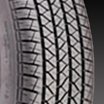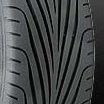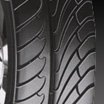Tyres are the fundamental link between your car and the road. A good set of tyres will improve the handling, steering, acceleration and braking of your car, and will make full use of any further modifications performed to your car. This article contains the bare essentials of choosing the right set of tyres for a typical passenger vehicle without getting too technical or specific.
There are five main elements you have to consider when choosing the right set of tyres for your vehicle -
1. Tube-type or tubeless
2. Size of tyre
3. Tread pattern
4. Rubber Compound
5. Overall quality of the tyre
1. Tube-type or tubeless
The answer to this question is very simple. Opt for tubeless tyres. They are safer, more advanced and have a few other small advantages too. You do
NOT need to have alloy wheels in order to use tubeless tyres. However, for the best results your steel wheels should be rust free (or just buy a new set as they are very cheap) and preferably have the insides coated with an anti-rust coating.
(Discuss : Tubeless Tyres On Steel wheels?) 2. Size
Size is probably the most talked about and controversial part of buying tyres if you are going for an upsize. Tyre sizes are represented in a standard format. For eg. 205/55 R 15, which can be read as follows:
205 (mm) - or 20.5cm is the width of the tread on the tyre.
55 (%) - is the height of the sidewall represented as a percentage of the tread width.
R (Radial) - Radial construction, as almost all tyres are nowadays.
15 (inches) - Is the rim diameter of the wheel on which this tyre is designed to fit.
Choosing the right size can be broken up into three decisions -
i. Rim size - You have to choose a tyre size designed for exactly the size of rim you plan to mount the tyre on. Larger rims will effectively reduce the sidewall height (making the tyre lower profile) and therefore minimize sidewall flex when cornering, adding to the "on rails" feel, however, this will obviously have an adverse effect on ride quality and comfort.
ii. Tread width - Generally a 0mm-20mm increase in width from the stock size is considered within the realm of sanity in the Indian context. Keep in mind that not only size, but tyre compound also plays a large role in "grippyness".
To get a better idea of whether you should upsize your tyre width (if at all) see the following chart -

Keep in mind that the tyre width also has an ideal wheel width which it works best with, try to keep this in mind otherwise you may end up having stability issues when braking hard or cornering.
(Scroll down to the Rim-Width calculator to find out if your rims will be ok for your new tyres)
If you increase the width of your tyres, you should also confirm that they do not touch the wheelwells of your car on turning the steering wheel all the way and when the car is under full load.
iii. Sidewall Height (or Profile) - After selecting your rim size and your tread width, the objective is to choose a sidewall profile that keeps the overall diameter of the new tyres as close to original as possible.
Use <this> calculator to judge changes in size. Generally a difference in the range of 3-4% is considered acceptable.
Keep in mind that a change in overall diameter (OD) of your tyre & wheel combo will cause a slight error in your speedometer readings and odometers readings, which is purely academic. Also your ground clearance may change very slight (half the change in diameter).
3. Tread Pattern
The tread pattern of a tyre has a major effect on the tyres wet weather performance, which depends on its ability to channel water away from the contact patch between the tyre and the road. The tread pattern also plays a part in how much road noise is generated by the tyre due to air getting trapped and expelled from those channels during running. Tests have shown that the tread pattern of a tyre does not have as much of an effect as the compound of the tyre when it comes to traction, but nonetheless it plays a part. (Unless ofcourse you are looking at a tyre for mud, snow or sand, in which case the tread pattern plays a vital role.). Never buy re-treaded tyres; they are dangerous and not worth the little money you save.
(Discuss on TBHP : Directional & Asymmetrical Tyres) i. Conventional Tread - Is the most commonly found type. It is neither (uni)directional nor asymmetric and therefore can be run in either direction or mounted on the rim either way.

ii. Uni-Directional - These tyres are designed to be most effective when rotating in the specified direction. There will always be a marking on the sidewall of these tyres stating the direction of rotation with an arrow. The tyres with the tread pattern in some sort of "A" or "V" configuration are usually uni-directional. They work more efficiently when rotating in the specified direction primarily in terms of water chanelling and controlling tyre noise.

iii. Asymmetric - These tyres are designed to have an outside/road facing sidewall and a inside/car facing sidewall. There will always be a notation on the sidewall stating which side is to be road-facing / outside. The advantage to asymmetrical tyres is, for example, the outside shoulder of the tyre tread can be designed with a different pattern and compound of rubber to aid high speed cornering (where a lot of the the load is transfered to the road facing side of the tyre on the outside of the curve) while the rest of the tyre can be designed with a harder compound for better treadwear, or a different tread pattern for better wet weather performance etc.

4. Rubber Compound
The rubber compound used to manufacture the tyre is probably the most important factor in determining a tyre's traction and treadwear characteristics. Generally, the quality ("softness") of the rubber is proportional to the amount of traction you will get and the speed rating of the tyre, and inversely proportional to the treadlife of the tyre. Therefore the higher the speed rating of a tyre, the better the grippyness of the tyre is likely to be. Also, the way the tyre is marketed is an indicator - the "ultra-sport" will usually have a grippier compound than the "sport" or the "comfort" tyres from the same manufacturer. The compound also plays a part in the behavior of a tyre in little ways, for example, some tyres will screech and wail when approaching the limits of traction, whereas others might just let out the faintest chirp and then begin to slide.
5. Overall Quality Of The TyreThings to consider are -
i. Reputation of manufacturer - Ask around, read reviews, do research or just go with a well known and trusted manufacturer. It does make a difference as they have more modern facilities, better quality standards and newer equipment at their manufacturing plants.
ii. Warranty - Read the fine print. There always is fine print.
iii. Date of Manufacture - Every tyre is stamped with a four digit DOT code on its sidewall which denotes the week (first 2 digits) and year (last 2 digits) of manufacture (eg. 2104 = 21st week of 2004). The fresher the tyre you buy, the better. Try not to buy tyres that are older than 6 months, and definitely nothing older than a year.
iv. Added Technologies - Each manufacturer has different little technologies and tricks that they apply to their tyres, and named something unique and cute; don't pay too much attention to these unless it is actually something revolutionary.
Additional links with more detailed and specific information -
1.
Car & Tyre Bible
2.
Team-BHP's Tyre and Alloy Wheel Section
3.
Wikipedia - Tyre
4.
The Best Set Of Tyres In India - User Opinions
5.
The Right Upsize - Discussion
 (20)
Thanks
(20)
Thanks

 (1)
Thanks
(1)
Thanks
 (4)
Thanks
(4)
Thanks

 (1)
Thanks
(1)
Thanks








